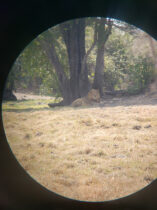
It is said that you hunt leopard with your brain, elephant with your feet, buffalo with your guts, and you hunt lion with your heart! Lion can be hunted throughout Africa and are a fantastic hunting experience. These big cats are a prized trophy and are pure excitement to hunt. You are scared 3 times on a lion hunt, first when you see the big tracks on the ground, next when you hear his intimidating roar, and for a third time when you lay your eyes on him. These big cats have a territory that they protect and hunting areas that they frequent. For baiting purposes larger baits are set up closer to the ground. High enough that the lions can feed with some effort and higher than Hyena can reach. Guts and stomach contents are scattered around the bait with the hope of drawing the cat in by smell. Lion hunting can be done in a blind waiting for a lion to feed or can be done by stalking the bait, typically early in the mornings to find the lion there at first light. Once on the bait, lions are typically easier to get a shot at than a leopard.
They don’t have much to worry about in the way of other animals and are confident in their position in the food chain. As with all dangerous animals accuracy is important when hunting lion. Lions can cause a lot more problems than just a few stitches. A good quality soft (Swift A-Frame or Barnes) in a .30 caliber will readily kill both a lion and a leopard. They are not thick skinned and are susceptible to hydrostatic shock, sometimes dying immediately with a well-placed bullet. They are extremely dangerous when wounded. Most places require a .375 minimum for all dangerous game; the bigger the better, as long as accuracy is not sacrificed. A trophy lion is not measured by the hair around its neck.
They are measured by size of their skull. A big mane is a nice addition to your trophy lion. Some areas produce lion with thick manes while other areas produce big bodied lions with very average manes. Lion are typically hunted a 21 day safari, exceptions on duration of the hunt can be made. Lion and leopard are hunted in small numbers and available licenses or quota is limited.
General Lion Information
- Male Lions: Average length 9 feet (2.7 meters)
Weight 350-450 lbs. (157-180 Kg.)
Height 36 in. (90 cm.)- Female Lions: Average length 8 feet (2.4 meters)
Weigh 250-300 lbs. (112-136 Kg.)
Height 30 in. (75 cm.)- Lengths include the tail. Height measured at the shoulder.
- Lifespan of a Lion: 12 years in the wild, 20 years in captivity. Females typically live a few more years in the wild.
- Maximum speed: 30 mph over 50 yds.
- Biggest Jump: 12 feet (3.7 meters) vertical, 36 feet (10.8 meters) horizontal.
- Gestation period: 105-115 days. (About 3 1/2 – 4 months)
A group of Lions is called a Pride. The hunting territory for a pride of lions can range from 8 to 150 square miles. Lions are the most social of all cats. Prides may contain up to 40 members, with over half being young adults and cubs. Most of the time this is not the case and many places have loosely associated prides with animals frequently hunting on their own. While lions in captivity will eat about 15 pounds of raw meat daily, a wild lion will only eat about twice a week. They are not above stealing other animal’s kills and scavenging meat.
Lions have hair rather than fur. Hair is defined as a single-layered, thin coat and fur is a double-layered, insulated coat. Although lions seem to be all one color, closer inspection reveals patches of white inside their legs and on their bellies. They are a tawny brown color.
Because most of a lion’s weight is made up of muscle, they are amazing athletes. With one slap of a paw they can knock a full-grown zebra off its feet. Like any good athlete, they need their sleep and a lot of it! Twenty hours out of each day is spent snoozing. Lion are ambush predators; they surprise their prey and overwhelm it with a quick burst of speed and a powerful attack. When an animal is killed, lions will eat virtually every part of it–the skin, meat, intestines. The four members of the cat family who can roar are lions, leopards, tigers, and jaguars. But lions are by far the loudest. When the mood is peaceful, lions may make puffing noises instead. “Meows” and other sounds are used as well. But a mighty roar can be heard as far away as 5 or 6 miles. A lion is incapable of roaring until he/she is about 2 years old.





















